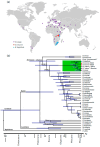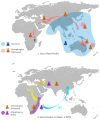Revisiting the History and Biogeography of Bactrocera oleae and Other Olive-Feeding Fruit Flies in Africa and Asia
- PMID: 39859611
- PMCID: PMC11766006
- DOI: 10.3390/insects16010030
Revisiting the History and Biogeography of Bactrocera oleae and Other Olive-Feeding Fruit Flies in Africa and Asia
Abstract
Bactrocera oleae Rossi causes important agricultural losses in olive growing regions. Despite its economic relevance, the expansion history and biogeography of B. oleae and other olive-feeding fruit flies remain unclear. We used mitogenomic data of Bactrocera species from a broad geographic range to explore possible historical biogeographic patterns in B. oleae and other olive-feeding fruit flies. Our data suggest that (1) the transition from stenophagy on Oleaceae to oligophagy on Olea most likely occurred in Africa more than 6 million years ago (MYA), and (2) the subsequent transition to monophagy on Olea europaea took place in Asia or in Africa in the Early Pleistocene. Our results support equally the hypotheses that the ancestors of modern B. oleae underwent two waves of migration from Asia to Africa or that they zigzagged between Asia and Africa.
Keywords: Olea europaea; Oleaceae; mitochondrial; olive fruit fly; phylogeography.
Conflict of interest statement
The authors declare no conflicts of interest.
Figures




References
-
- The Elder P. In: Natural History. Rackham H., translator. Harvard University Press; Cambridge, MA, USA: 1950. pp. 153–155. In Book 17.
-
- Rice R.E., Phillips P.A., Stewart-Leslie J., Sibbett G.S. Olive fruit fly populations measured in Central and Southern California. Calif. Agric. 2003;57:122–127. doi: 10.3733/ca.v057n04p122. - DOI
-
- Ramezani S., Blibech I., Rei F.T., Van Asch B., DA Costa L.T. (Diptera: Tephritidae) in Iran: An invasion from the Middle West. Eur. J. Entomol. 2015;112:713–721. doi: 10.14411/eje.2015.097. - DOI
-
- Hoelmer K.A., Kirk A.A., Pickett C.H., Daane K.M., Johnson M.W. Prospects for improving biological control of olive fruit fly, Bactrocera oleae (Diptera: Tephritidae), with introduced parasitoids (Hymenoptera) Biocontrol Sci. Technol. 2011;21:1005–1025. doi: 10.1080/09583157.2011.594951. - DOI
-
- Daane K.M., Johnson M.W., Pickett C.H., Sime K.R., Wang X.-G., Nadel H., Andrews J.W., Hoelmer K.A. Biological controls investigated to aid management of olive fruit fly in California. Calif. Agric. 2011;65:21–28. doi: 10.3733/ca.v065n01p21. - DOI
LinkOut - more resources
Full Text Sources

